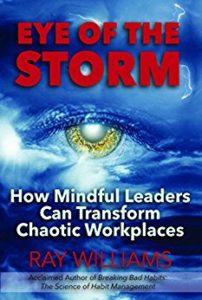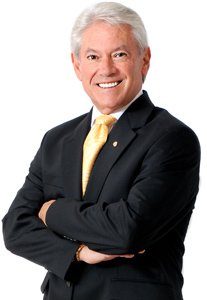By Ray Williams, January 4, 2019
In my book, Eye of the Storm: How Mindful Leaders Can Transform Chaotic Workplaces, I outline in detail the characteristics of toxic workplaces.
Characteristics of a Toxic Workplace:
- All sticks and no carrots. Management focuses solely on what employees are doing wrong or correcting problems, and rarely give positive feedback for what is going right. Or mostly carrots for the best performers, sticks for the the rest.
- The creeping bureaucracy. There are too many levels of approval and management to get things done and a singular focus on micromanaging employees;
- The gigantic bottom line. A singular focus on profits, beating the competition and cost cutting without consideration of other bottom lines.
- When bullies rule the roost. Bullying of employees by management, or tolerated by management when it occurs among employees.
- Losing the human touch. People are considered to be objects or expenses rather than assets, and there is little concern for their happiness and/or well-being.
- High levels of stress, turnover, absenteeism and burnout.
- Instituting internal competition among employees enforced by a performance assessment system that focuses on individual performance rather than team performance.
- Little or no concern for work-life balance, where a personal or family life must be sacrificed for the job.
- Overwork or workaholism, commonly evidenced by 50 hr+ workweeks, little or no vacation time and 24/7 availability for work communication;
- Little evidence of leaders’ compassion and empathy for employees.
- Little or no commitment to making contributions to the community, worthy causes or making the world a better place.

Jeffrey Pfeffer, Thomas D. Dee Professor of Organizational Behavior at the Stanford Graduate School of Business and the author of The Human Equation: Building Profits by Putting People First, outlines in his book how companies that treat their people right get enormous dividends–high rates of productivity, low rates of turnover. Pfeffer disputes much of the conventional wisdom in the current conversation about work and business. Loyalty isn’t dead, he insists — but toxic companies are driving people away. There isn’t a scarcity of talent — but there is a growing unwillingness to work for toxic organizations.
The great irony, says Pfeffer, is that most workplace policies that are bad for employees are also bad for companies themselves. Organizations that are more “humane” — offering generous benefits, sick leave, vacation pay, health insurance, and so forth — are shown to be more profitable. Examples are Southwest Airlines, Kimberley-Clark, Whole Foods, CostCo and of course, Google. Google is a profitable business with high standards and where sharing differences of opinion (link is external)is encouraged, according to some. Yet the company has realized the public value of building a caring employee culture. Others do, as well. SAS, the software company, is famous for respecting the fact that its employees have a life outside the office. Workers there are on a 35-hour work week. SAS has been acknowledged as “The World’s Best Place to Work.”
Some would argue that it doesn’t matter if the workplace culture enhances employee well-being as long as the company makes a profit for shareholders. Despite the fact that that utilitarian “ends justifies the means” philosophy is a throwback to 19th and early 20th century industrialism, it’s actually not born out by research evidence. First, in Amazon’s case, some have argued the company is actually not profitable. Almost 20 years after it was launched, it has yet to report a meaningful profit. According to Yahoo Finance , the company earned only a slim 1% operating margin during the last 2 years. For all Amazon’s remarkable revenue growth, the company has still not demonstrated that it can generate profits consistently. Now, investors in the company may finally be running out of patience, Graham Ruddick writes in theThe Telegraph.
A Harvard Business School study of more than 60,000 employees found that “a superstar performer–one that models desired values and delivers consistent performance” brings in more than $5,300 in cost savings to a company. Avoiding a toxic hire, or letting one go quickly, delivers $12,500 in cost savings.
The cost of incivility can run into the millions, the study says:
- Employees subjected to incivility in the workplace experience “markedly loosened bonds with their work life”.
- Nearly half of employees “decreased [their] work effort” and intentionally spent less time at work.
- 38 percent “intentionally decreased” the quality of their work.
- 25 percent of employees who had been treated with incivility admitted to taking their frustrations out on customers.
- 12 percent left their jobs due to uncivil treatment.
Not surprisingly, toxic employees alienate their co-workers and team members, which also directly impacts the bottom line:
- 80 percent of employees lost work time worrying about the offending employee’s rudeness.
- 78 percent said their commitment to the organization declined in the face of toxic behavior.
- 66 percent said their performance declined.
- 63 percent lost worktime in avoiding the offender.
Stanford University professor Jeffery Pfeffer, professor of organizational behavior at Stanford University’s business school and author of a new book, “Dying for a Paycheck.” estimates that 120,000 deaths may be attributed to workplace conditions, which include work-family conflict, no health insurance, and unemployment. This would in theory make the modern workplace the sixth-leading cause of death in the United States. Pfeffer found toxic workplace environments permeate all types of companies across multiple industries and in various countries. He found plenty of issues with both old and newer companies, including places like Salesforce, which is currently listed as Fortune’s “Best Place to Work.”
People who work for bosses who display psychopathic and narcissistic traits not only feel more depressed due to their bosses bullying behaviour they are also more likely to engage in undesirable behaviours at work.These are the key findings of a research team from the University of Manchester’s Business School. Lead researcher Abigail Phillips who presented his findings at the British Psychological Society’s annual conference of the Division of Occupational Psychology in Liverpool.
One could also argue that Amazon work practices—even the issue of productivity—is not supported by research. For example, the relentless pushing for more and more productivity through extended working hours, and even workaholism may actually harm productivity. Research shows that exhausted, overworked people make bad decisions and big mistakes. Second, exhausted, overworked people are seldom innovative, at least not for very long.The expression “killing yourself at work” takes on new meaning with the publication of a massive research study on the topic. The scientists looked at data from 25 studies involving over 600,000 individuals and assessed if there was a relationship between heart events like heart attacks and strokes with standard work weeks (35-40 hours a week) compared with long work weeks (>55 hours). After adjustments for age and other known risk factors, the long work week was associated with a increased risk of heart events and particularly with stroke events. In fact, the more hours one works, the greater the risk of stroke.

What about productivity?
“People-centered organizations often outperform their profit-centered counterparts seven ways to unleash the full potential of your people,” says Daniel Goleman, author of the best selling book, Focus: The Hidden Driver of Excellence, and winner of the McKinsey award for the best HBR article of the year, “The Focused Leader.” He goes on to say “Studies conducted by companies evaluating their own executives have proven taht the the top 10 percent of performers displayed superior comeptencies in emotional intelligence, which includes empathy and a focus on teamwork.”
In his book, Drive , Daniel Pink, describes what he says is “the surprising truth” about what motivates us. Pink concludes that extrinsic motivators work only in a surprisingly narrow band of circumstances; rewards often destroy creativity and employee performance; and the secret to high performance isn’t reward and punishment but that unseen intrinsic drive—the drive to do something because it is meaningful. Pink says that true motivation boils down to three elements: Autonomy, the desire to direct our own lives; mastery, the desire to continually improve at something that matters to us, and purpose, the desire to do things in service of something larger than ourselves. Pink, joining a chorus of many others, warns that the traditional “command-and-control” management methods in which organizations use money as a contingent reward for a task, are not only ineffective as motivators, but are actually harmful.
In an article by Richard Williams, Wallace Higgins and Harvey Greenberg, published in the Boston Globe, they cited numerous research studies regarding leadership style and the health of employees. They concluded “your boss can cause you stress, induce depression and anxiety or even trigger the onset of serious illnesses. It is not just bad managers who can negatively affect employee health, but it is also the lackadaisical and mediocre who put employees on the sick list.” And the cost is huge in terms of lost productivity, healthcare costs and employee turnover. The authors argue that a whole new field of litigation in the U.S. is developing-“lawsuits against ‘bad bosses’ and the organizations that negligently allow them to supervise.”
Christina Boedker of the Australian School of Business conducted a research study on the link between leadership and organizational performance and collected data from more than 5600 people in 77 organizations. She concluded that the ability of leaders to spend more time and effort developing and recognizing people, welcoming feedback, and fostering co-operation among staff were critical to success. Moreover, out of all the various elements in a business, the ability of a leader to be compassionate, “to understand people’s motivators, hopes and difficulties and to create the right support mechanism to allow people to be as good as they can be,” had the greatest correlation with profitability and productivity, Boedker concluded.
William Baker and Michael O’Malley, authors of Leading With Kindness argue that the practice of kindness in corporations has a positive impact on bottom line business results. They argue that a management style, which could be called transformational, that has these traits—compassion, integrity, gratitude, authenticity, humility and humor—improves employee performance and employee retention.

Jonathan Haidt, author of Righteous Mind, reflects the view of Edward O. Wilson, David Sloan Wilson and others who argue that when groups of animals compete, it’s the cohesive, cooperative, internally altruistic groups that win and pass on their genes.
Frans de Waal is author of The Age of Empathy: Nature’s Lessons For A Kinder Society. (De Waal is a biologist, professor of psychology and director of the Living Link Center at Emory University. In 2007, Time magazine selected him as one of the world’s most influential people. The distinguished scientist says it is long overdue that we jettisoned our beliefs about human nature—proposed by economists and politicians—that human society is modeled on the perpetual struggle for survival that exists in nature. De Waal says this is mere projection on our part. Nature is replete with examples of cooperation and empath
Given all we know about empathy in other animal species, why do we persist in seeing human existence, particularly in business, as a fight for survival, with winners and losers? De Waal calls this the “macho origin myth” which insists that the human species has been waging war on itself as millennia as a reflection of our true nature. What has been ignored is the fact that empathy has been evident during that entire time. De Waal points to a mass of examples of sacrifice, empathy, co-operation and fairness in humans and other animals’ species.
The idea of a humble CEO is a romantic departure from the greedy self-serving corporate hero. Rather, when faced with adversity, humble CEOs sacrifice their own interests for the greater good.
Studies echo the intuition that humble leaders are more modest, emotionally stable, and eager to learn. Unsurprisingly, they are less likely to display self-aggrandizing traits such as narcissism.
Perhaps most telling is the finding that companies and teams led by more humble individuals, perform better. But despite humility being good for business, it’s extremely difficult for CEOs to be genuinely humble.
But there is a greater tragedy brewing if current and future business leaders think Amazon does represents the future of management. The techniques that Amazon uses to manage its own people can destroy the lives of individuals and undermine organizational performance. The decision to rank and yank is based more on a commitment to an outdated ideology than any real business benefits it might bring.
A commitment to short term profits at human and social costs can’t be the future of business in America can it? Is the proliferation of toxic work cultures really what we want for the sake of financial gain?
Copyright: Neither this article or a portion thereof may be reproduced in any print or media format without the express permission of the author.
Read my latest book: Eye of the Storm: How Mindful Leaders Can Transform Chaotic Workplaces, available in paperback and Kindle on Amazon and Barnes & Noble in the U.S., Canada, Europe and Australia



